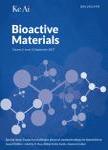In-situ solvothermal processing of polycaprolactone/hydroxyapatite nanocomposites with enhanced mechanical and biological performance for bone tissue engineering
作者机构:Department of Materials Science and EngineeringSharif University of TechnologyTehranIran Institute for Nanoscience and NanotechnologySharif University of TechnologyTehranIran
出 版 物:《Bioactive Materials》 (生物活性材料(英文))
年 卷 期:2017年第2卷第3期
页 面:146-155页
核心收录:
学科分类:0831[工学-生物医学工程(可授工学、理学、医学学位)] 0710[理学-生物学] 08[工学] 0805[工学-材料科学与工程(可授工学、理学学位)] 080502[工学-材料学] 0836[工学-生物工程]
基 金:AS wish to thank funding support from Sharif University of Technology(SUT,No.G930305) Iran National Science Foundation(INSF No.95-S-48740)
主 题:Nanocomposite Polycaprolactone Hydroxyapatite Mechanical property Cytotoxicity
摘 要:The interest in biodegradable polymer-matrix nanocomposites with bone regeneration potential has been increasing in recent *** the present work,a solvothermal process is introduced to prepare hydroxyapatite(HA)nanorod-reinforced polycaprolactone in-situ.A non-aqueous polymer solution containing calcium and phosphorous precursors is prepared and processed in a closed autoclave at different temperatures in the range of 60-150℃.Hydroxyapatite nanorods with varying aspect ratios are formed depending on the processing temperature.X-ray diffraction analysis and field-emission scanning electron microscopy indicate that the HA nanorods are ***-dispersive Xray spectroscopy and Fourier transform infrared spectrometry determine that the ratio of calcium to phosphorous increases as the processing temperature *** evaluate the effect of in-situ processing on the mechanical properties of the nanocomposites,highly porous scaffolds(90%)containing HA nanorods are prepared by employing freeze drying and salt leaching *** is shown that the elastic modulus and strength of the nanocomposites prepared by the in-situ method is superior(~15%)to those of the ex-situ samples(blended HA nanorods with the polymer solution).The enhanced bone regeneration potential of the nanocomposites is shown via an in vitro bioactivity assay in a saturated simulated body *** improved cell viability and proliferation is also shown by employing(3-(4,5-dimethylthiazol-2-yl)-2,5-diphenyl tetrazolium bromide)(MTT)assay in human osteosarcoma cell *** prepared scaffolds with in vitro regeneration capacity could be potentially useful for orthopaedic applications and maxillofacial surgery.



